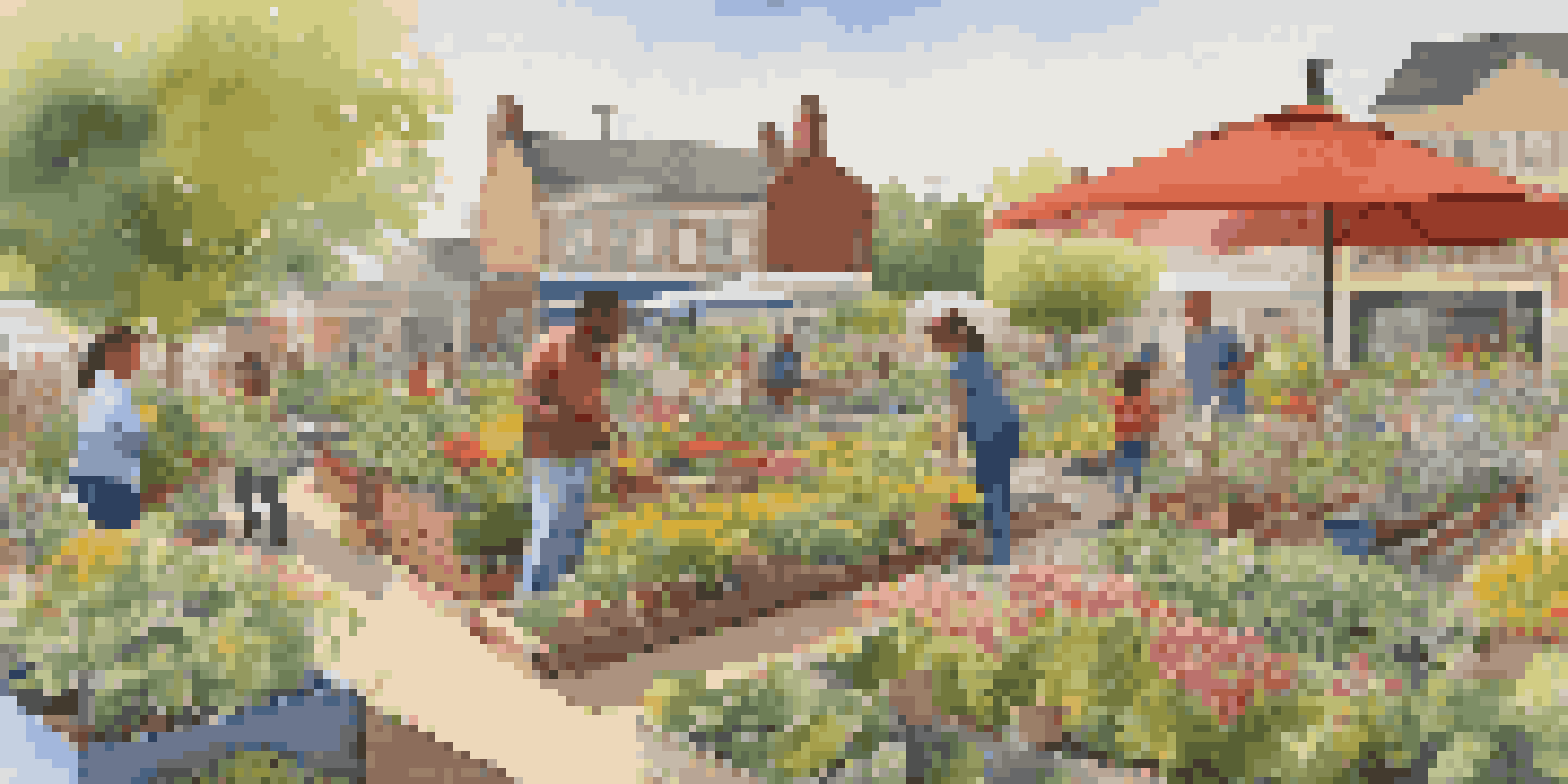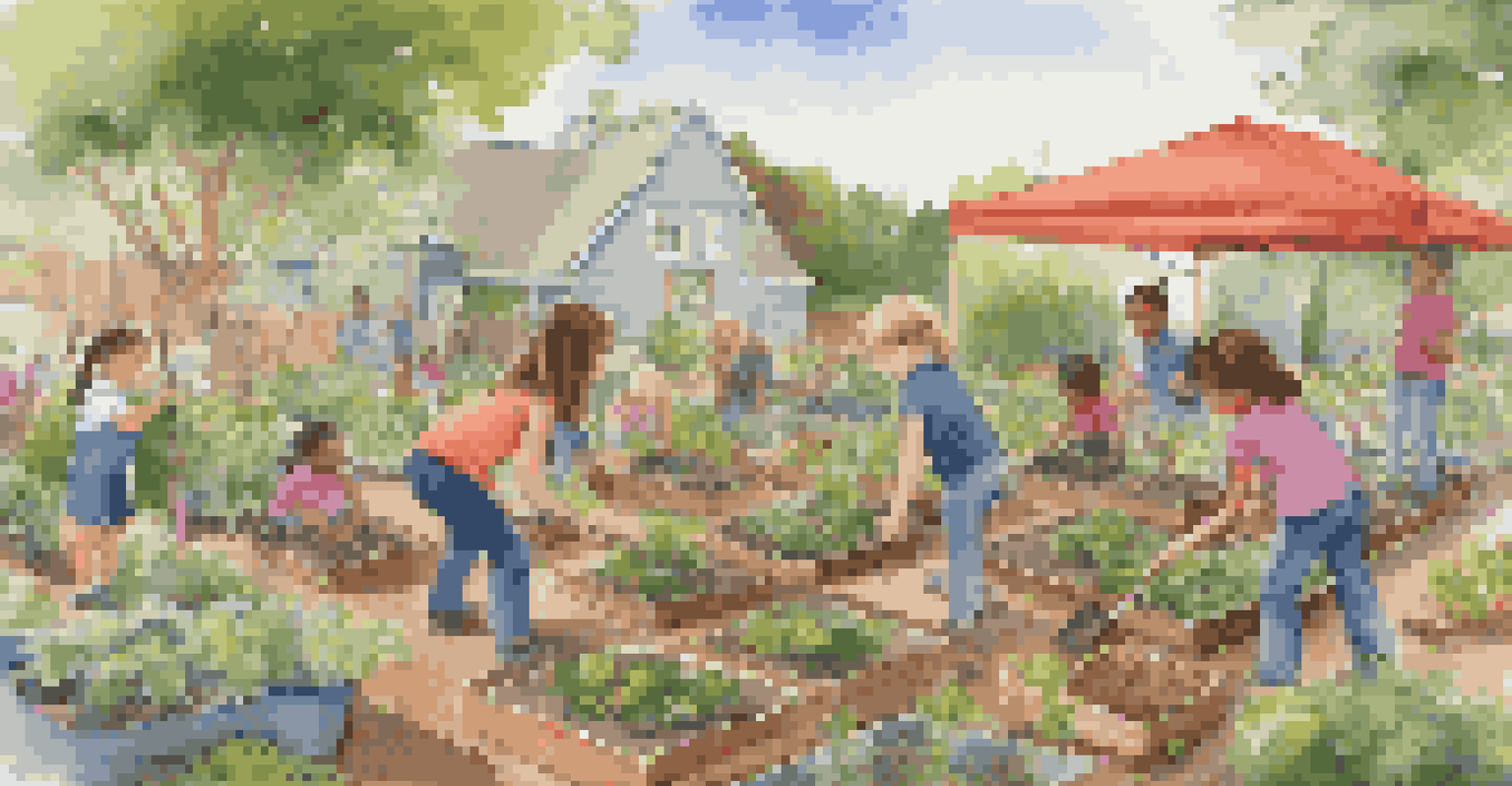The Role of Community Gardens in Urban Sustainability

What Are Community Gardens and Their Benefits?
Community gardens are shared spaces where people come together to grow plants, vegetables, and flowers, typically in urban areas. These gardens serve as green oases, providing not only fresh produce but also a sense of community. They often transform vacant lots or underutilized spaces into vibrant ecosystems that foster biodiversity.
The best time to plant a tree was twenty years ago. The second best time is now.
One of the primary benefits of community gardens is their ability to promote food security. By growing their own food, urban dwellers can access fresh, nutritious options that may be scarce in local grocery stores. This self-sufficiency can significantly improve the dietary habits of the community while also reducing reliance on processed foods.
In addition to food production, community gardens offer numerous social benefits. They create opportunities for neighbors to connect, share knowledge, and build relationships. This sense of belonging can enhance mental well-being, making community gardens a crucial aspect of urban life.
The Environmental Impact of Community Gardens
Community gardens play a vital role in promoting urban biodiversity. By introducing various plants and flowers, they attract pollinators like bees and butterflies, which are essential for maintaining healthy ecosystems. This diversity not only beautifies the neighborhood but also supports local wildlife.

Moreover, these gardens help combat the urban heat island effect—where cities become significantly warmer than surrounding areas due to human activities. The greenery in community gardens provides shade and cools the air, contributing to a more comfortable environment for residents. This simple act of planting can have profound effects on local climate.
Community Gardens Boost Food Security
By growing their own food, urban residents gain access to fresh produce, enhancing their diets and reducing reliance on processed options.
Additionally, community gardens improve air quality by absorbing carbon dioxide and releasing oxygen. Plants act as natural air filters, which can be especially important in densely populated urban areas where pollution levels are high. By investing in community gardens, cities can take significant steps toward a healthier environment.
Community Gardens and Climate Resilience
As climate change continues to pose challenges globally, community gardens can enhance urban resilience. They serve as spaces for growing food locally, reducing the carbon footprint associated with transporting produce from rural areas. This localized food production is essential in building a more sustainable urban future.
Gardening is a way of showing that you believe in tomorrow.
In times of crisis, such as natural disasters or supply chain disruptions, community gardens can provide a reliable source of food for residents. They offer a buffer against food insecurity, ensuring that communities can sustain themselves even when outside resources are limited. This self-reliance fosters a sense of empowerment among community members.
Furthermore, community gardens often incorporate sustainable practices like composting and rainwater harvesting. These methods not only reduce waste but also promote responsible water usage. By integrating such practices, gardens can model sustainable living, inspiring others to adopt eco-friendly habits.
Promoting Social Equity Through Gardening
Community gardens are powerful tools for promoting social equity within urban settings. They often provide marginalized groups with access to land and resources that they might otherwise lack. This access can lead to improved health outcomes and greater community empowerment, fostering a sense of ownership among participants.
These gardens also offer educational opportunities, teaching individuals about sustainable practices, nutrition, and gardening techniques. Workshops and community events can attract people from diverse backgrounds, promoting inclusivity and cultural exchange. Such interactions can break down barriers and create a more united community.
Gardens Promote Social Equity
Community gardens provide marginalized groups with resources and opportunities, fostering inclusivity and addressing disparities in access to healthy food.
By emphasizing social equity, community gardens can address the systemic issues that often lead to disparities in access to fresh food. They work to create a more just food system, where everyone has the opportunity to grow and enjoy healthy food, regardless of their socio-economic status.
The Role of Community Gardens in Education
Community gardens serve as outdoor classrooms, providing hands-on learning experiences for people of all ages. Schools and educational organizations often partner with gardens to teach students about biology, ecology, and the importance of sustainable practices. These lessons can be far more impactful than traditional classroom settings.
Through gardening, children learn responsibility and the importance of nurturing life. They discover where food comes from and the hard work involved in growing it. This connection to nature can instill a sense of stewardship, encouraging future generations to care for the environment.
Moreover, community gardens can facilitate workshops for adults, covering topics like organic gardening, cooking, and nutrition. These programs can empower individuals with knowledge that enhances their quality of life, promoting healthier eating habits and encouraging sustainable living practices.
Challenges Faced by Community Gardens
While community gardens offer numerous benefits, they also face challenges that can hinder their success. One common issue is securing funding and resources to maintain the gardens. Without proper financial support, it can be difficult to keep the gardens thriving and accessible to the community.
Another challenge is navigating land use regulations and zoning laws. In some areas, community gardens may struggle to gain legal approval or face opposition from local authorities. This can make it tough for community members to establish and sustain their gardens.
Gardens Enhance Urban Sustainability
Through local food production and eco-friendly practices, community gardens contribute to climate resilience and improved environmental health.
Additionally, the turnover of gardeners can impact the continuity of the garden's management. When dedicated members leave, it can create gaps in knowledge and commitment, potentially leading to a decline in the garden's health. Building a strong, committed community is essential for overcoming these challenges.
Looking Ahead: The Future of Community Gardens
The future of community gardens looks promising, as more urban areas recognize their value in promoting sustainability. With growing awareness of climate issues and food security, cities are more inclined to support and invest in these green spaces. This trend is encouraging for communities seeking to enhance their local environment.
Innovative approaches, such as vertical gardens and rooftop farms, are also emerging as solutions to urban space limitations. These adaptations allow for even more people to engage in gardening, regardless of their living situation. As cities become denser, these creative solutions will play a crucial role in the gardening movement.

Furthermore, technology can enhance the community gardening experience. Digital platforms can connect gardeners, share resources, and facilitate collaboration. As community gardens continue to evolve, they will remain vital in fostering sustainable practices and strengthening community ties.